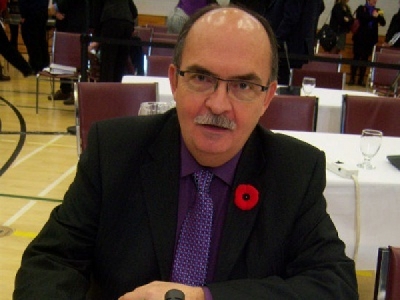
Posted on November 17, 2016
By Valerie MacDonald, Northumberland Today
Much of the back and forth between the Commission, its staff and the Canadian Nuclear Laboratories which has been licenced the low-level radioactive waste cleanup, came as a result of questions and concerns raised by representatives of the Lake Ontario Waterkeeper about Port Hope’s harbour.
While the Waterkeeper’s Wilf Ruland described the project of moving all the waste into two state-of-the-art facilities (one at Port Granby and the other in Welcome) and effluent treatment in the new waste treatment plants as a “good news story for Port Hope” – he expressed concern about the lack of a plan to remove the contamination from the water in the harbour.
Without a plan for management of the contamination while “going down to bedrock” on the harbour floor, this is a significant issue, he said, as is the lack of downstream testing.
Long-time and senior low-level radioactive waste advisor, Glenn Case, was called on to reply to Ruland.
The plan for remediation of the harbour has been in place a long time and the contamination will be removed in a controlled environment, Case said. There will be new walls installed around the harbour, sediment will be placed in tubes and place on the centre pier and the water from them will be treated before going back into the harbour, he said.
Commissioner Sandy McEwan said that he believed the highest possibility of something going wrong would be in the dredging operation, and wanted more information.
The dredging will be in two phases with the bulk removal followed by a second one of vacuuming sediment from the hard bottom, Case explained. The “geo tubes” will be reused over and over again with the sediment drained of water going to the waste storage facility.
Is the goal “swimmable water?” asked Commission President Dr. Michael Binder.
“The long-term objective is that all of the waste be removed so there is no concern around dredging in the future,” said Case who is retiring in April and whose last official duty was testifying before the Commission.
Ruland said he was still not reassured by this detail. He said he understood the harbour was to be sealed while the low-level radioactive sediment was removed but information he has received about a “porous barrier” means to him that “water will be going in and out…from a messy cleanup site.”
Commissioner McEwan said he was also concerned about contaminated water going out into the lake.
Case assured them there was a gated attenuation system to control the water and a silt curtain to be employed.
“It will be all very controlled,” he said.
Canadian Nuclear Safety Commission staffer John Thelen said “contaminants won’t reach Lake Ontario” and that the “water will be protected.”
Binder asked who would see that contaminants aren’t released into Lake Ontario and Thelen said that would be done by Canadian Nuclear Laboratories – and that ongoing testing was part of the licensing requirements.
Fellow CNSC staffer, Kiza Sauve, said that testing will take place before dredging work begins as well as during and after.
Ruland persisted in his position that if there is a plan for the harbour dredging, “I couldn’t find one.”
When queried by Bender about water testing, David Bradley of the Ontario environment ministry said “it has been agreed that there is a need for a robust monitoring system” and CNSC staffer Kavita Murthy said there is an agreement in place between Environment Canada and Oceans and Fisheries. But Sandra Faught of the Canadian Nuclear Laboratories said there will be discussions concerning the need for Department of Fisheries permits.
At the end of these assurances, Ruland remained unconvinced. He said he was “greatly concerned” and described the harbour dredging process “a weak link” in the cleanup.
“I thought the harbour was to be sealed,” he said. “Now I’m hearing there will be an ongoing flow of water into the lake.”
If that is the case, there needs to be ongoing monitoring for all contaminants and the results need to be made public on an ongoing basis, he added.
Ruland’s colleague in the joint presentation, Pippa Feinstein, focused on the absences of set limits for contamination of the effluent leaving the waste water facilities and being discharged into Lake Ontario, plus the need for more inter-jurisdictional participation by the federal and provincial environmental authorities. Regulatory limits need to be set on a defined list of metals and contaminants, she pressed. As it relates to the harbour dredging, she reiterated Ruland’s position that there must be a rigorous monitoring of contaminates plan, and that data be share with the public, as well as the federal and provincial regulators.
Feinstein asked that joint regulatory agency meetings report out so people are aware of the decisions being made and that real time data be put on the website about any incidents or spills so they are made public quickly.
Among recommendations listed in Waterkeeper’s written submission were:
• Both the Welcome and Port Granby waste management facilities “be immediately amended to include an effluent discharge level of .15 mg/L for uranium;
• The Port Hope waste water treatment plan’s effluent monitoring system “be more comprehensive”;
• “Surface water monitoring downstream from the Port Hope waste facility be explicitly delineated and more comprehensive, and that downstream water monitoring from both treatment plants “continue as long as the facilities are operating.”
• That the Port Hope Area Initiative (PHAI) must include a plan for managing contaminated water in the harbour during the PHAI and VIM dredging and excavation activity. And that a plan is needed to address how contaminated harbour water will be treated and managed once dredging and excavation work ceases and the harbour mouth is open again.
Source: Northumberland Today





